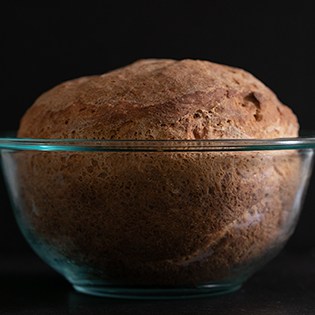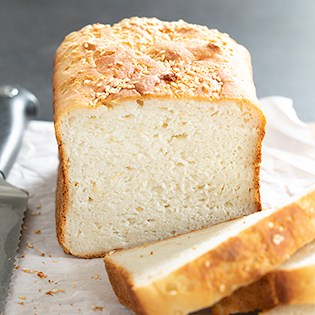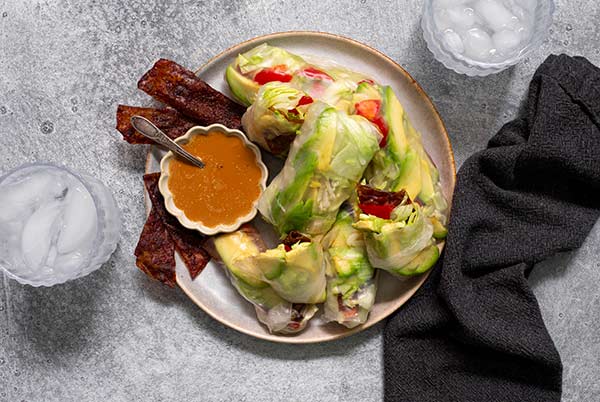Once you learn how to make gluten free bread with yeast, you’ll be ready to select your first bread recipe and get started with confidence. Follow me as we tackle the science of gluten free baking, so you can produce the best gf bread.
Rule # 1: Don’t stray from tried and true gluten free bread recipes
Try to avoid making any substitutions the first time you make a gluten free bread recipe, especially one which is unfamiliar to you. If you have chosen a recipe that you can only make with substitutions, select another recipe.
Whenever a reader tells me that they are having trouble with a recipe, my first question is always whether they have made any substitutions. Some may work, but many will not. And early failure will make it very hard to stay motivated.
The easiest gluten free bread recipe to begin with is the recipe for the white gluten free bread recipe from my first cookbook. It’s a super simple recipe, and there’s a detailed video that allows you to watch over my shoulder as I make the bread. It’s pictured right below this paragraph.
Rule # 2: Measure your dry ingredients by weight, not volume
Bake by weight (grams and pounds), not volume (cups). Proper proportions make the difference between success and failure. A serviceable scale is totally cheap, and easy to use. I recommend this one (affiliate link).
To use a digital scale, simply finish measuring one ingredient, and hit “tare.” It zeroes out the scale. Ready for the next ingredient, in the same bowl. Precision, easily.
In all of my recipes, 1 cup of all purpose gluten free flour weighs 140 grams. Don’t bother trying to see if the measuring cups you have in your kitchen match their volume to my weight measurements.
A common misunderstanding is that you can “test” my weight measurements by comparing them to the corresponding volume. I provide volume measurements as a courtesy, since we Americans tend to resist baking by weight, but I hope you will ignore them.
Volume measurements are prone to human error and are inherently imprecise. Ignore the volumes, and focus only on the weight of each ingredient.
Rule # 3: Make sure all ingredients are thoroughly blended
Gluten-free bread dough needs to be mixed vigorously until smooth with a stand mixer. If you don’t have a stand mixer, you can try using a food processor fitted with the steel blade, and pulsing just until the dough is smooth.
Avoid using a hand mixer with balloon whisk attachments, since the bread dough will get caught in the whisks and not worked into a smooth dough properly. The most important thing is that the ingredients get incorporated fully and that the dough is smooth.
And don’t worry about over-mixing. There’s no gluten to ‘overwork.’ If your end result has a really tight crumb and seems crumbly, it’s not that you overworked the dough. Your hydration level was likely too low.
If you don’t have any appropriate mixing appliance, try my recipe for gluten free artisan bread. It’s a rustic bread that is made with dough that’s especially wet, which allows you to mix the dough by hand in one bowl. It’s a great everyday gluten free bread recipe.
The yeast bread recipes that I’ve developed to be made with my gluten free bread flour, on the other hand, require an electric mixer with the dough hook attachment, and for that you can use a stand mixer or a 5-speed handheld mixer, with dough hook attachments.
Rule # 4: Gluten substitutes are vital for making gluten free bread that holds together
Don’t try to bake bread without any gluten substitutes, like xanthan gum. When yeast gives off carbon dioxide during the baking process, gluten acts like a cloak and suspends the bubbles.
When gluten traps the rise, it allows the bread to bake around the air pockets. Without gluten and without a gluten substitute, there’s nothing to “hold” the rise. Xanthan gum also keeps baked goods fresher longer.
Some people find that they react poorly to “the gums,” which generally refers to xanthan gum and guar gum, and prefer not to bake with them. Xanthan gum is better suited to heated applications like bread baking, and guar gum to cold applications like making ice cream. However, my gluten free bread recipes are developed to require baking with xanthan gum.
What about psyllium husk for gluten free bread?
Psyllium husk is a form of fiber (think: Metamucil) that has become relatively popular in gluten free bread baking as a replacement for xanthan gum. I’ve tried it, and I simply haven’t found a way to use it that produces a bread product that I like to eat.
Psyllium husk does add significant flexibility to raw gluten free bread dough, makes gluten free loaf bread that looks great, and is easy to handle. But I find it adds both an unpleasant taste, aftertaste, and mouth feel. Since bread’s highest and best use is eating, those are deal-breakers for me.
When America’s Test Kitchen came out with their first gluten free bread recipes, they asked me to endorse them. I worked my way through some of their basics, which included a heavy reliance on psyllium husk.
It does behave similarly to xanthan gum, and is even more effective for breads because it’s even more hydrophilic (water-loving). And yes, I used the brand of psyllium husk that they recommend.
I promise you’ll be the first to know if I change my opinion of baking bread with ground psyllium husk. I wonder if I might prefer it used in smaller amounts, and with whey protein isolate, which I use in my gluten free bread flour.
Rule # 5: Don’t bake gluten free bread without an oven thermometer
Use a simple oven thermometer to gauge your oven’s baking temperature properly. Most ovens are calibrated improperly, and off by around 50°F. Yup. That much. My oven is typically off by about 75°F!
I don’t bother having the oven calibrated, since it will just drift out of calibration again. Instead, I use a simple analog oven thermometer that’s easy, cheap, essential. I just replace it at least twice a year, and never worry whether my oven temperature is accurate.
When you bake bread in a too-hot oven, the outside will bake before the inside has a chance to develop enough structure to support it. The bread will then cave in on itself as it cools.
Rule # 6: Use the right gluten free flour blend to bake gluten free bread
Personally, I most often bake my gluten free bread with Better Batter’s classic gluten free flour blend. It’s such a versatile blend, and it’s always worked beautifully for any recipe that’s called for an all purpose gf flour.
Better Batter is made with a blend of brown rice flour, white rice flour, tapioca starch, potato flour, potato starch, xanthan gum, and powdered pectin.
Curious about whether I know the exact ratio of these ingredients? It turns out I actually do, so if you can’t find Better Batter locally or simply prefer to make your own, all you need to do is follow my recipe for Mock Better Batter.
My DIY gluten free flour blend works exactly like the original version, so you can use it anywhere that calls for Better Batter — including most of my gluten free bread recipes.
Some of my bread recipes call for a very specialized gluten free bread flour blend that adds whey protein isolate and Expandex modified tapioca starch to Better Batter, but those recipes will call out the gluten free bread flour blend specifically.
Those breads that call for our gluten free bread flour blend will require fewer enrichments like eggs and butter, and the dough will be handled more like conventional yeast bread. But the recipe will be very specific about the requirement to use the bread flour, and that isn’t most of the bread recipes here on the blog.
Your flour choice matters. A lot.
For starters, you have to use the right gluten free flour mix, as discussed above. If you use a blend like, for example, King Arthur gluten free flour, your yeast bread will not turn out. Even that company suggests avoiding their flour blend for yeast breads!
There are a lot of gluten free flour options out there, including but not limited to, brown rice flour, potato flour, millet flour, coconut flour, oat flour, buckwheat flour, sorghum flour, and almond meal.
But just because a certain flour is gluten free does not mean you can throw it into a gluten free bread recipe and expect good results. Or any meaningful results, for that matter.
Use the gluten free flour mix that each particular recipe calls for. In most cases, it will be Better Batter, but it could be different depending on the type of bread.
Rule # 7: Yeast bread rises slower in cool, dry environments
Create the right environment for bread proofing. If you can swing it, consider a Brod & Taylor bread proofer. It’s amazing the even rise you can get in this little box of heaven. I got mine for free (I was a ‘tester’), but I would have bought it.
If you can’t swing it, use my tried and true microwave-as-bread-proofer method. I used it for years and years, with good results. It creates a contained warm, moist environment for your yeast bread to rise.
Rule # 8: Make sure your bread dough doesn’t dry out
Yeast won’t rise without enough moisture. If the recipe you’re following calls for a first rise in the refrigerator, be sure that it is in a container like a Cambro bucket that seals properly, or moisture will evaporate, drying out the dough and preventing rise.
Rule # 9: Set your yeast up for success
Yeast can generally survive the cold of my refrigerator at 40°F/4°C, and water as hot as 120°F/49°C will likely kill yeast. Anything in between and your yeast should survive.
But surviving is different from thriving. Yeast in bread dough needs a few conditions to thrive:
- Enough moisture (without enough moisture, or if your raw dough loses too much moisture, the yeast won’t be active)
- Enough time (yeast will rise more slowly at lower temperatures, but it will rise given enough time)
- Freshness (check the date on your yeast and don’t use anything past its freshness date)
There are a few conditions that will inhibit the growth of your yeast:
- Too much salt (don’t add yeast and salt in at the same time, and don’t overmeasure your salt, which inhibits yeast growth)
- Too much sugar (which will absorb liquid in the dough; a proper sweet yeast bread recipe will already have accounted for that by adding more yeast)
- Too much heat (I do not recommend setting your bread dough to rise in an oven that’s on, even if you’re certain it’s only set to 100°F; most ovens won’t retain a temperature setting that low and your yeast will probably die)
Rule # 10: Don’t let a boxed gluten free bread mix discourage you
You’ll notice a lot of gluten free bread mixes at the grocery store. These pre-packaged mixes promise delicious gf baked goods with minimal effort, but they usually fall flat.
If you’ve tried one of these mixes with disastrous results and think that all gluten free baking is destined for the same bland, dry, and crumbling outcome, please don’t!
I promise that if you follow one (or several, or all) of my gluten free bread recipes, you’ll enjoy bread that is better than anything you can find in a box.
Don’t always have the time to bake fresh? I can totally relate. Check out my review of the best gluten free bread brands that you’ll find at local markets and online for the tastiest packaged options.
My best gluten free bread recipes
I’ve got lots of recipes for gluten free bread, but I think these are some of my best. Take a look to find a new favorite or five, and then keep reading for even more gluten free baking tips.
This sweet, rich bread is so delicious, you’ll be reaching for it all day long. I love having it at breakfast… and lunch… and dinner… and dessert!

This gluten free white sandwich bread recipe is the original, game-changing, batter-style gf bread recipe that delivers big on taste and texture, even for total beginners. Follow the tips in this post, and you will be successful!
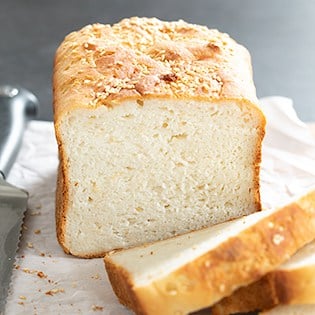
Made with traditional ingredients, this gluten free naan recipe is quick and easy to put together. I love having it with huge helping of curry.
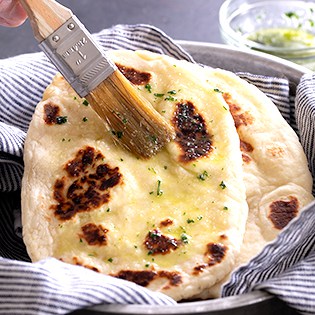
My brown bread gives you the hearty taste of wheat bread, without any of the wheat. It has tons of flavor and will elevate any sandwich experience.

This gluten free dough lets you bring pizza night right into your kitchen. Homemade pizza just tastes better, especially when it’s got a chewy, crispy-edged crust.
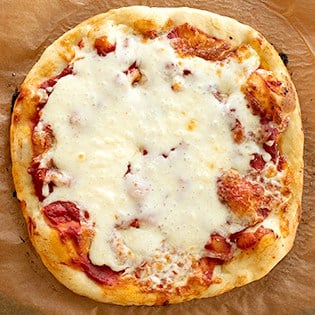
A delicious gluten free sandwich bread, my English muffin bread is a white bread that’s ready from start to finish is just a couple of hours.
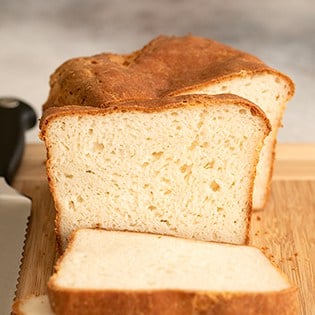
These gf dinner rolls are so squishy and buttery that you’ll be pulling this recipe out for all types of occasions, from pasta night to Christmas dinner.
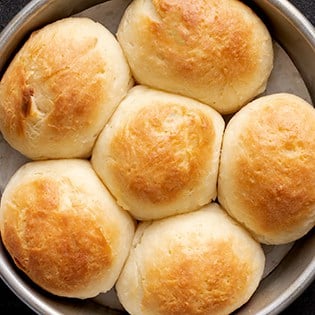
Say goodbye to “lettuce” hamburger buns — I’ve brought bread back to the table with this quick recipe. These buns come out like those fancy ones at the bakery.

If you’re craving a more flavorful sandwich bread, you won’t go wrong with this sourdough recipe. Rather than conventional yeast, it uses a wild yeast sourdough starter.

These classic loaves of gluten free French bread are just as crusty outside, soft and tender inside, as you remember. They’re even quick and easy enough to make on a weeknight!
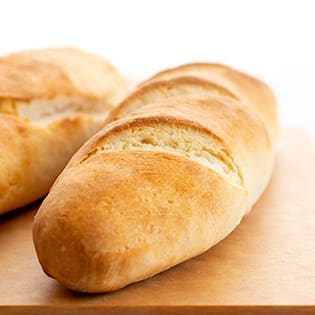
With a soft center, crunchy crust, and tons of garlicky goodness, this recipe for gf garlic bread is a must for those nights when you’re making spaghetti, lasagna, and other pasta dishes.
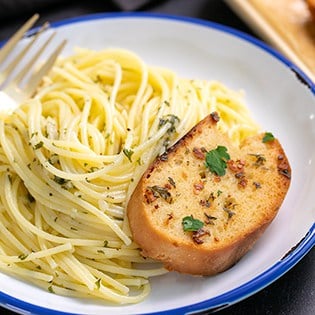
This incredibly delicious monkey bread recipe is perfect for making with little helpers. The result is an ooey, gooey treat that the whole family will love.
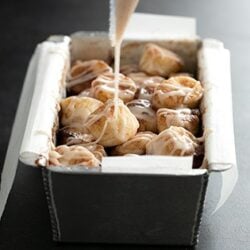
Make and shape all the shaped breads from your favorite pizza place with this recipe for gluten free calzone dough. Fill it with your favorites and shape it as a calzone, or roll it up into stromboli!
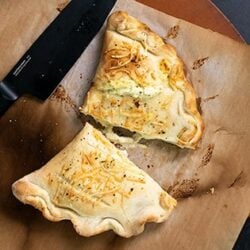
Just because you can’t have grains or dairy doesn’t mean you can’t have yeasted pizza! This paleo pizza crust tastes just like the “real” thing, and might just become your new favorite pizza of all.
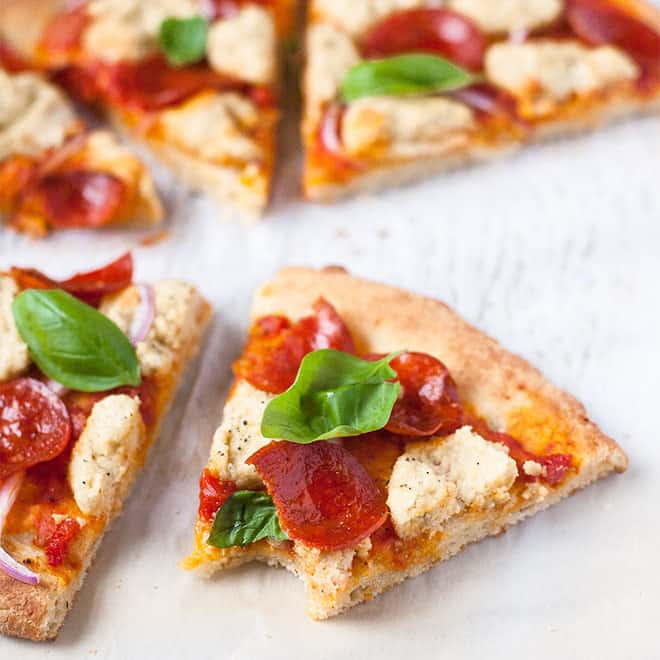
These plain gluten free bagels have the authentic chew inside, and thin, crisp shell of a real, NY-style boiled bagel. Enjoy them with a schmear of cream cheese, or make the best sandwich of your life!
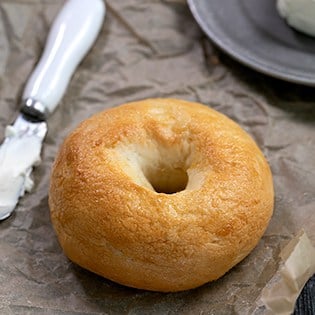
These gluten free steamed Chinese meat buns have a simple savory meat mixture wrapped in pillow-soft steamed dough. Cook in a steamer basket or in soup!

More tips for baking with gluten free flour and making gluten free bread
Common gluten free bread ingredients
Each of my gf bread recipes contains different ingredients that I’ve carefully tested time after time. But most of the recipes do share a few common ingredients. These include:
- All purpose gluten free flour blend – In most cases, I use Better Batter’s classic gluten free flour blend. It offers just the right ratio of ingredients and really helps replicate the taste and texture of “real bread”. I don’t care for their “rice-free blend,” which uses psyllium husk, at all, I’m afraid.
- Tapioca starch/flour – Even when you use Better Batter, which contains tapioca starch/flour, many of my bread recipes call for more tapioca starch as an added ingredient. Don’t skip it! It helps make the dough much easier to handle, and gives it significantly more chew when baked.
- Xanthan gum – You only need to include xanthan gum if your gluten free flour blend doesn’t already contain it. Xanthan gum is essential for maintaining your bread’s rise and structure.
- Yeast – As the yeast feeds off the sugars in your bread dough, it releases carbon monoxide, which creates bubbles as it escapes. This causes the dough to swell and rise, resulting in airy bread rather than a dense clump. My recipes typically call for “instant yeast,” also called rapid-rise or breadmaker yeast, which isn’t soaked first. If you must use active dry yeast, you’ll need 25{5676e3b156b07d12bd9df9fe13d641a85da396026abde11a1ff2d0afc1b3c015} more yeast, by weight, and to soak it in some of the liquid from the recipe first.
- Sugar – Sugar feeds yeast, but it also tenderizes your bread, helps with moisture retention, and adds flavor.
- Salt – Salt is an obvious flavor enhancer (your gf bread would taste rather bland without it), but it also helps regulate your bread’s rise, keeping it from rising too fast, only to sink later.
- Milk – Adding milk to a gf bread recipe that calls for it helps produce a softer crumb.
- Butter – Like milk, butter contributes to a softer bread. The fats in butter keep the bread chewy and tender, and give it flavor in enriched breads.
- Eggs – Eggs acts as a binder and leavening agent, helping your bread come together and stay together.
Gluten free bread ingredient substitutions
I know that many of my readers try to avoid other potential allergens, so whenever possible, I offer substitution ideas in my recipes. As I explain in my recipes, I haven’t always tried these substitutions so you may have to experiment a bit, but I’ll let you know why I think they work.
Every bread recipe is different, but here are some common substitutions you can make to avoid typical allergens:
Gluten free, dairy free bread recipes
You can typically replace milk with dairy free alternatives like soy milk, almond milk, coconut milk, and oat milk. Just make sure to use a non-sweetened variety, so it doesn’t affect the bread’s flavor.
In most cases, you can substitute traditional butter with a vegan butter. I particularly like the offerings from Melt and Miyoko’s Kitchen, but Earth Balance Buttery Sticks may work in some instances too.
Gluten free, egg free bread recipes
For those wheat free bread recipes that call for 1 or 2 eggs, you may be able to use chia eggs instead. The recipe for each chia egg is 1 tablespoon ground chia seeds + 1 tablespoon lukewarm water, mixed and allowed to gel.
I’ve not used chia eggs in my gluten free baking, but I have lots of readers who’ve had great success. In place of egg whites, you may sometimes be able to use aquafaba (the brine from a can of chickpeas).
Gluten free, vegan bread recipes
In most cases, you can follow my substitutions for dairy and eggs to make vegan bread. Plus, select your granulated sugar carefully to ensure it’s not made with bone char.
However, some recipes may call for other non-vegan ingredients that we haven’t discussed here, so be sure to carefully review the recipe that you’d like to try for the most relevant info.
Gluten free bread internal temperature
In each of my recipes, I advise you on how long it typically takes to bake a loaf of gluten free bread. Unfortunately, these figures might not always work for you.
This is because ovens can vary widely in operating temperature — the thermostat may say it’s 350 degrees in your oven, but it could easily be off by 50°F to 75°F.
As most ovens fall out of calibration, here’s how to tell if bread is done:
- Use a stand-alone oven thermometer to gauge oven temperature, and replace it frequently (they’re super cheap)
- Insert an instant-read thermometer in the middle of your loaf, reaching down to the bottom of the loaf, but don’t touch the pan.
- If you’re not certain whether your loaf bread is baked all the way to the center, you can usually remove it from the pan, place it on a small baking sheet, reduce the oven temperature, and continue to bake it until it sounds hollow when thumped on the bottom or side.
Using a bread machine for gluten free bread
I don’t really recommend using a bread machine to make gluten free bread. I’m not saying that it’s not possible, but I don’t really see the point: Mixing and baking gf bread is simple enough as it is, and bread machines differ so significantly from brand to brand that you’d need a different recipe for each.
But if you do want to use a bread maker to help with mixing and/or baking, here’s what I suggest.
For mixing, look for the bread machine setting that offers just one mixing cycle as that’s all that your bread needs. If you can’t find that setting, see if you can manually set the bread machine to mix for about 20 minutes.
Once your bread batter or dough is mixed, you can remove it from the bread machine and continue baking as per recipe instructions.
If you’d like to bake your bread in the bread maker, look for the gluten free setting. Many modern machines have it, which offers appropriate rise and baking times.
If your bread machine doesn’t have a gluten free setting, look for a rapid or quick rise setting, or set it manually to do a one-hour rise and one-hour bake.
Cooling and slicing your gluten free bread
As with most bread, gluten free bread is a bit delicate straight out of the oven. For this reason, as tempting as it may be, you should not immediately cut into it. (And yes, it’s very tempting, I know!)
Instead, remove your bread from the oven and allow it to cool for at least 10 minutes. Then, take your gf bread from the loaf pan and allow it to cool completely on a wire rack.
Removing your gluten free bread from the loaf pan will prevent it from getting soggy by allowing steam to escape. Letting it cool completely will ensure it retains it shape for neat and easy slicing.
How to store gluten free bread
Because my best gluten free bread recipes don’t contain preservatives, your bread won’t last as long as store-bought bread. That’s okay, though, because bread tends to disappear into bellies faster than I can keep up with.
To store your gf bread for everyday use, keep it at room temperature on your countertop, covered tightly, and it should last the day. For longer storage, I recommend against the refrigerator, as it is very drying.
Instead, freeze your gluten free bread for use in the future. Make sure it has completely cooled, then slice it, wrap it in freezer safe wrap like Glad Press ‘n’ Seal, and then put it inside a freezer safe, zip top bag.
Your gluten free loaf bread will last up to three months with proper storage. Defrosting your bread is as easy as pulling out a bagel or a slice of bread, letting it defrost a bit at room temperature or in the microwave, sprinkling it with a bit of water, and refreshing it in a toaster oven.
Gluten free baking troubleshooting and FAQs
What is in gluten free bread?
Every gluten free bread recipe is different, but you’ll find many of the same ingredients in a gluten free version as you will in a traditional one.
For example, my gluten free potato bread recipe uses all purpose gf flour, tapioca starch/flour, potatoes, milk, sugar, eggs, and yeast like most bread recipes.
Is yeast gluten free?
Yes, bread-making yeast is naturally gluten free. Brewer’s yeast is typically gluten-containing, though, so select your yeast carefully.
What gluten free flour is best for yeast bread?
My favorite gluten free flour for yeast bread is Better Batter. It offers the perfect ratio of several gluten free flours to create gf bread that looks and tastes just like “the real thing”.
What can replace gluten in flour for making bread?
Nothing is a one to one replacement for gluten in yeast bread, but xanthan gum as part of a well balanced all purpose gluten free flour blend goes a long way to making gluten free bread that stretches and bends.
What gluten free bread is closest to regular bread?
If you’re looking to buy packaged gluten free bread, I really like Schar brand and Canyon Bakehouse brands are some of the best. Here is a complete list of my favorite packaged gluten free bread.
Is all gluten free bread wheat free?
No. Wheat is one of the main gluten-containing grains, so if something is gluten free then it is probably also wheat free. Some bread may be gluten free but contain gluten free wheat starch, which may be appropriate for someone with celiac disease or gluten sensitivity but could trigger an allergic reaction in someone who is allergic to wheat.
What is the secret to getting gluten free bread to rise?
My favorite way to get gluten free bread to rise is to turn on my oven to its lowest setting (usually less than 200°F), cover the bread dough well with either a lid or oiled plastic wrap, and place it on top of the oven. The oven will give off enough ambient heat to help speed up the bread’s rise, but not so much that it will kill the yeast.
Does gluten free bread taste different?
When you pick a gluten free bread recipe from my extensive collection, there’s one thing I can promise you: It won’t taste bad.
In most cases, I would even say that these wonderful recipes don’t taste all that different from their gluten-containing counterparts.
And in a few magical cases, I’ll say that my gluten free bread recipes actually taste better than “the real thing”.
Do I have to knead gluten free bread?
No, you usually do not need to knead gluten free bread dough, at least not in the same style you might be used to from conventional bread. When making gluten free loaf bread, you simply have to vigorously mix ingredients to be sure they’re well incorporated.
Although you will often shape the bread into rolls, buns, loaves, or even gluten free soft pretzels, there are no gluten proteins to stretch, so no kneading is necessary.
Why is my gluten free bread not rising?
There are several reasons why your gluten free bread may not be rising. Here are a few of the most common reasons:
- You’re not using the correct gf flour blend or you’re not using the correct amount
- Your yeast is not fresh or it’s not activating due to use of cold ingredients
- You didn’t allow enough time or the proper conditions for proofing
- You didn’t measure your ingredients by weight, including water, so the hydration ratio is wrong
Why is gluten free bread so dry?
GF flours are very absorbent, so if you don’t include the right ratio of dry and wet ingredients, you’ll end up with a gluten free bread loaf that’s dry and crumbly.
Honestly, if you want to know how to make gluten free bread fluffy, the best thing you can do is follow your chosen recipe’s instructions very carefully.
Also remember that the more substitutions you make, the more likely you’ll end up with something different than the intended result.
Why is my gluten free bread so crumbly?
Lack of moisture will make gluten free bread dry and crumbly, but so will inadequate amounts of xanthan gum. Look at this important ingredient as a type of binder or glue that holds gluten free bread together.
Why is my gluten free bread gummy?
While it’s possible to include too little liquid in your gluten free bread recipe and end up with dry bread, you’ll experience the opposite if you add too much liquid, don’t let the dough rise enough before baking, or don’t bake the loaf for long enough until it’s baked all the way to the bottom.
Another reason you may pull gummy bread from the oven is that the bread wasn’t baked at a high enough temperature, so you don’t get any “oven spring.” If your oven runs too hot, the outside may bake too quickly and you can’t bake it long enough to bake all the way to the center. Finally, altitude, humidity, or temperature may affect final results.
How to tell if bread is done? Make sure your internal bread temp is between 205°F to 210°F.
Why did my gluten free bread sink while it was cooling?
The most common reasons for gluten free bread sinking after cooling include:
- Too much proofing; the bread rose higher than it could support itself. Raw gf bread dough tends to take on a pock-marked appearance when it’s overproofed, so watch carefully.
- Too much yeast; the bread rose too quickly and couldn’t support itself
- Too much liquid; steam couldn’t dissipate quickly enough
- A too-hot oven that baked the outside to burning long before the inside of the loaf was cooked through enough to support the structure.
Does gluten free bread need to be refrigerated?
No, gluten free loaf bread does not need to be refrigerated. In fact, you should avoid refrigerating bread as it will speed up the drying process.
Does homemade gluten free bread last as long as store-bought bread?
Many store-bought breads are loaded with preservatives to make them last longer than homemade baked goods.
As my bread recipes don’t contain preservatives, they won’t technically last as long as store-bought — but it’s typically not a problem because bread gets eaten quickly and freezes very well. Plus, xanthan gum is a necessary ingredient in gluten free bread and it helps keep baked goods fresher, longer.
Where can I find an easy gluten free bread recipe?
I’ve got a few of my best gluten free bread recipes above, but you can find more at my gluten free bread archive.
I consider most of my gf bread recipes to be easy gluten free bread recipes because I don’t use complicated ingredients or require specialized equipment. Even if you’re new to gf baking, I’m sure you’ll find these recipes simple enough (and I’d love to hear about how your bread turned out!
[These links contain affiliate codes that help me earn a small commission, at no additional cost to you. Every single product I recommend is one I truly believe in and, where appropriate, have purchased myself!]
Originally published on the blog in 2012. Lots of textual resources added in 2023.
